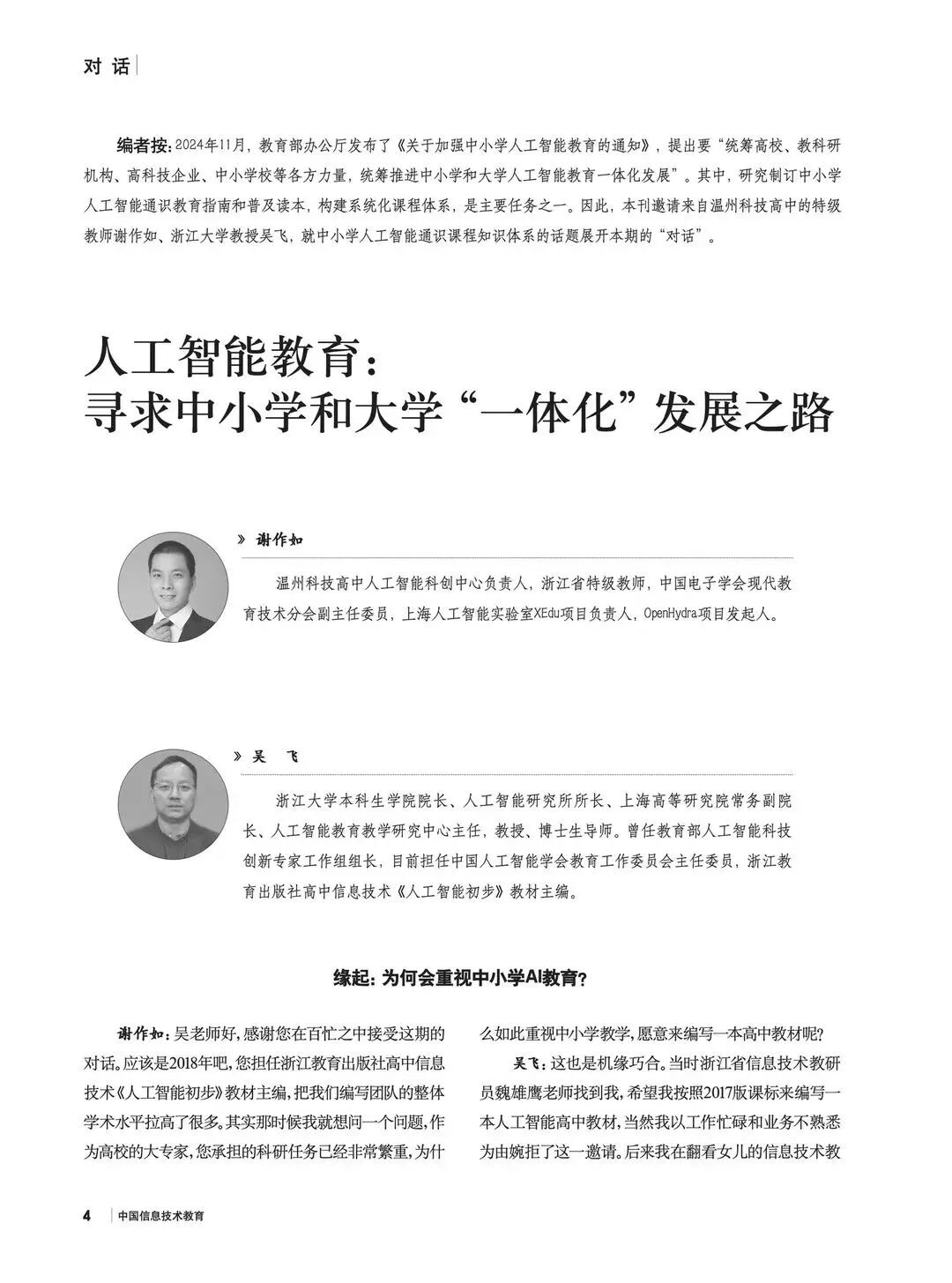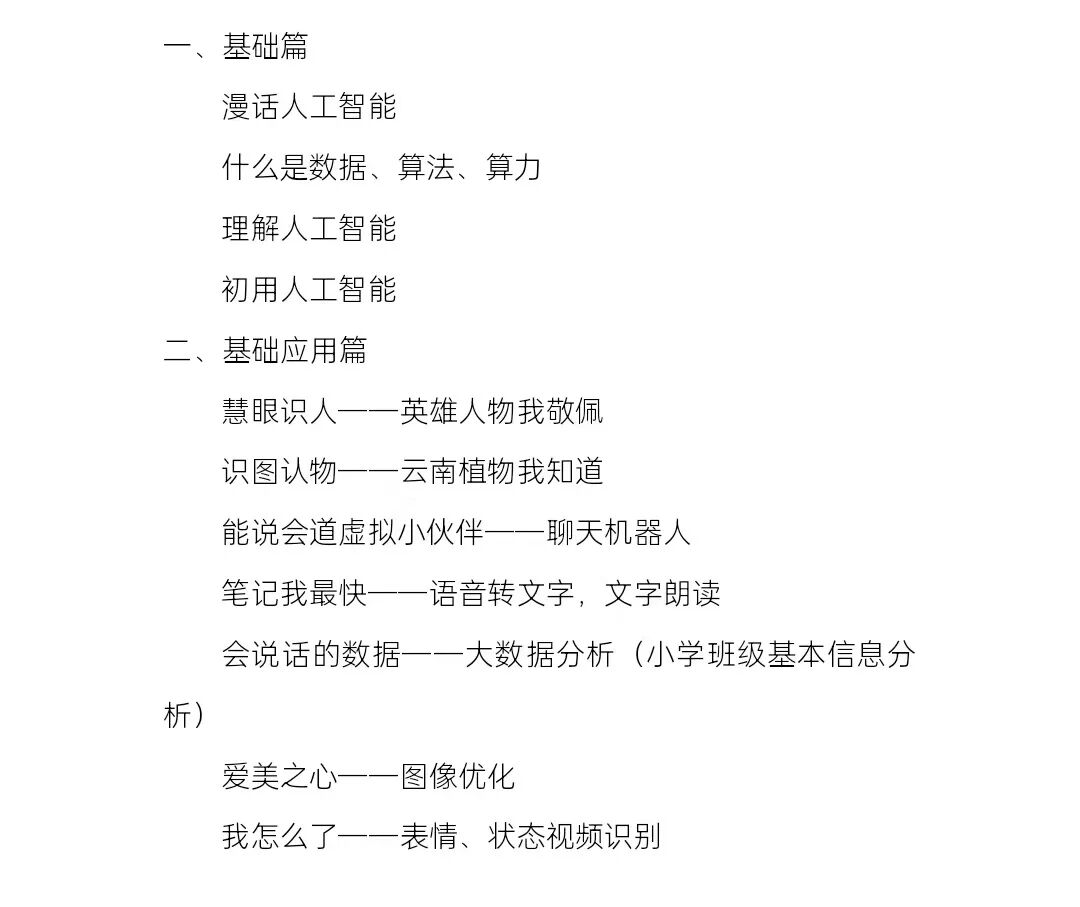It has been a long time since I last worked on my public account. I have many thoughts, but upon seeing the overwhelming amount of artificial intelligence textbooks and various articles on AI-enabled teaching, along with the numerous applications of Deepseek, I find that most are just jumping on the bandwagon and riding the hype. There are not many genuine cases that thoughtfully consider how AI can change education.
During the Qingming holiday, I had a rare opportunity to recharge and carefully organized my observations and thoughts.
In the April 2025 issue of China Information Technology Education, there was a dialogue article by teachers Xie Zuoru and Wu Fei, as shown in the screenshot below:

After carefully reading the entire interview article, I used AI to analyze the text content. Combining my understanding of AI education-related courses and textbooks, I generated the following framework using Meta AI:
Everyone can click the link above to view it.
After studying the dialogue between the two masters, my first reaction regarding AI education in Yunnan Province is that we cannot simply copy the theoretical framework from Zhejiang; otherwise, we will encounter the issue of “technological suspension.” This is not unfounded; recently, at a textbook exchange meeting at a university in Yunnan, I saw a similar AI course directory, with some screenshots below:

There are some changes, but it is likely that frontline teachers will find it not very user-friendly.
In the spirit of “Passion is Eternal”, let us think together: how can we develop AI courses with regional characteristics in Yunnan?
Thus, I have the following framework for discussion:
Path Design for Developing Regionally Characteristic AI Courses in Yunnan
As a multi-ethnic province on the frontier, Yunnan faces real challenges in educational development, such as weak infrastructure, a shortage of qualified teachers, and significant urban-rural disparities. Directly transplanting AI course systems characterized by high-end algorithms and hardware reliance from developed regions will lead to “technological suspension”—that is, a disconnect between teaching content and local needs, resource mismatches, and low student engagement. By integrating Yunnan’s ecological, cultural, and industrial characteristics, we can construct a localized AI education system from the following six dimensions:
1. Deep Coupling of Course Content with Local Needs: Shifting from “Technology-Driven” to “Problem-Driven”
Yunnan’s unique fields such as agriculture, tourism, ethnic cultural preservation, and ecological monitoring can all serve as entry points for AI course design, achieving an organic integration of technology learning with real-world scenarios.
Intelligent Agricultural Practices: Design courses for AI pest and disease identification and smart irrigation systems, integrating Yunnan’s specialty agriculture such as coffee, tea, and flowers. For example, use image recognition technology to analyze crop growth conditions and collect data through sensors to train predictive models.
Digital Preservation of Ethnic Culture: Combine AI with ethnic languages and traditional crafts. For instance, develop a minority language learning tool based on speech recognition, use generative AI to design ethnic patterns, or restore ancient buildings through 3D modeling.
Ecological Monitoring and Environmental Education: Relying on Yunnan’s rich biodiversity, carry out AI-driven species identification and forest fire warning system design projects to cultivate students’ abilities to use technology to solve ecological problems.
Case Reference: The Ruihe Experimental School in Wuhua District, Kunming, guides students to monitor water quality around the campus using open-source hardware through the “AI + Ecology” project-based learning, successfully integrating technology learning with local environmental issues.
2. Technical Tool Adaptation: Building a Low-Threshold, High-Inclusivity Teaching Resource System
Given the insufficient hardware facilities and limited technical capabilities of teachers in some areas of Yunnan, it is necessary to select lightweight and easy-to-operate technical tools to reduce the difficulty of teaching implementation.
Platform Selection: Use “no-code AI development platforms” developed by companies like Tencent Education, allowing students to complete basic applications such as image classification and speech synthesis through drag-and-drop modules without complex programming.
Hardware Optimization: Prioritize the use of low-cost open-source devices (such as Raspberry Pi and Arduino) instead of high-end servers, and conduct teaching using mobile terminals like smartphones to adapt to the equipment conditions of rural schools.
Development of Localized Resource Packages: Collaborate with universities and enterprises to build a teaching resource library that includes Yunnan dialect voice databases and specialty flora and fauna image datasets, addressing the mismatch between general datasets and local scenarios.
Policy Support: Yunnan Province’s “New Generation Artificial Intelligence Development Plan” clearly states the need to “promote the development of intelligent education platforms” and supports school-enterprise cooperation to develop educational tools that adapt to frontier characteristics.
3. Innovation in Course Forms: Developing School-Based Courses that Integrate “Ethnic Characteristics + Modernity”
Drawing on the experience of Nanguang School in Yunnan with “localized aesthetic education” (such as courses on sugar painting and pottery), AI education can explore the following paths:
Interdisciplinary Theme Design: Integrate AI technology with ethnic arts, geography, biology, and other subjects. For example, incorporate the generation of Dai brocade patterns into an “AI Painting” course, or analyze the market trends of Pu’er tea in a “Data Analysis” course.
Layered Teaching Model:
Basic Level: For all students, focusing on digital literacy and AI ethics (such as information verification and data privacy);
Expansion Level: For interested students, conduct project-based learning (such as developing AI minority language translation tools);
Advanced Level: Collaborate with university laboratories to provide top students with advanced training in algorithm optimization and hardware integration.
Practical Case: Yunnan University collaborates with iFLYTEK to offer an “AI + Minor Languages” course, cultivating compound talents with both technical skills and understanding of ethnic culture, which can be extended down to primary and secondary schools.
4. Teacher Capability Building: Constructing a Collaborative Support Network of “Universities-Enterprises-Government”
Only 23% of information technology teachers in Yunnan’s primary and secondary schools have experience in teaching AI, necessitating the enhancement of teacher capabilities through multiple channels:
University Empowerment: Relying on projects like Yunnan University’s “AI Smart Courses,” develop teacher training course packages covering pedagogy, case design, and technical practice.
Enterprise Participation: Introduce technical teams from companies like Tencent and iFLYTEK to help teachers master cutting-edge tools through on-site guidance and online workshops.
Localized Research and Teaching Community: Establish a collaborative network of teachers at the county level to share localized lesson plans and teaching resources, for example, developing AI course templates around the ecological monitoring of the Hani terraced fields in Honghe Prefecture.
Policy Assurance: Yunnan Province proposes to “improve the vocational training education system and establish a school-enterprise joint, industry-education integrated training model,” providing institutional support for teacher training.
5. Reconstruction of Evaluation System: From “Technical Proficiency” to “Problem-Solving Ability”
To avoid technological suspension, it is necessary to establish an evaluation mechanism oriented towards practical application:
Process Evaluation: Record students’ collaboration, research, and iteration abilities in projects, rather than focusing solely on code accuracy.
Social Value Assessment: Encourage project outcomes to serve the local community. For example, the “Erhai Water Quality AI Monitoring System” developed by a certain middle school in Dali was adopted by the local environmental protection department, and such contributions can be included in course credits.
Competition and Display Platforms: Through the Yunnan Provincial Youth AI Innovation Practice Activities, select outstanding projects to participate in national competitions, enhancing students’ sense of achievement and regional identity.
6. Ecological Construction: Multi-Party Collaborative Mechanism Driven by Policy
Government-Led Planning: Implement the “Yunnan Province New Generation Artificial Intelligence Development Plan,” establish special funds to support the construction of AI laboratories in rural schools, and incorporate the effectiveness of course implementation into educational supervision assessments.
Regional Resource Linkage: Establish a three-tier radiation network of “demonstration schools in provincial capital cities—base schools in cities and states—supporting schools in rural areas,” narrowing the urban-rural gap through online research and teaching and equipment sharing.
Industry Feeding Back Education: Guide local AI companies (such as Yunnan Quantu Education) to open internship positions, allowing students to participate in real projects in smart healthcare, cross-border e-commerce, etc., forming a closed loop of “learning-practice-employment.”

Conclusion
AI education in Yunnan needs to move beyond the mindset of “technology transplantation” and instead anchor itself in regional characteristics. By localizing course content, adapting tools, localizing teacher training, and implementing practical evaluations, we can build a “low-threshold, high-value” educational ecology. In this process, the government should act as a resource integrator, enterprises as technology enablers, and schools as innovation testing grounds, ultimately achieving a symbiotic and prosperous relationship between AI education and frontier development.
“A glimpse through the pipe”—my personal thoughts may be somewhat one-sided, and I welcome readers to reply and engage in discussion.